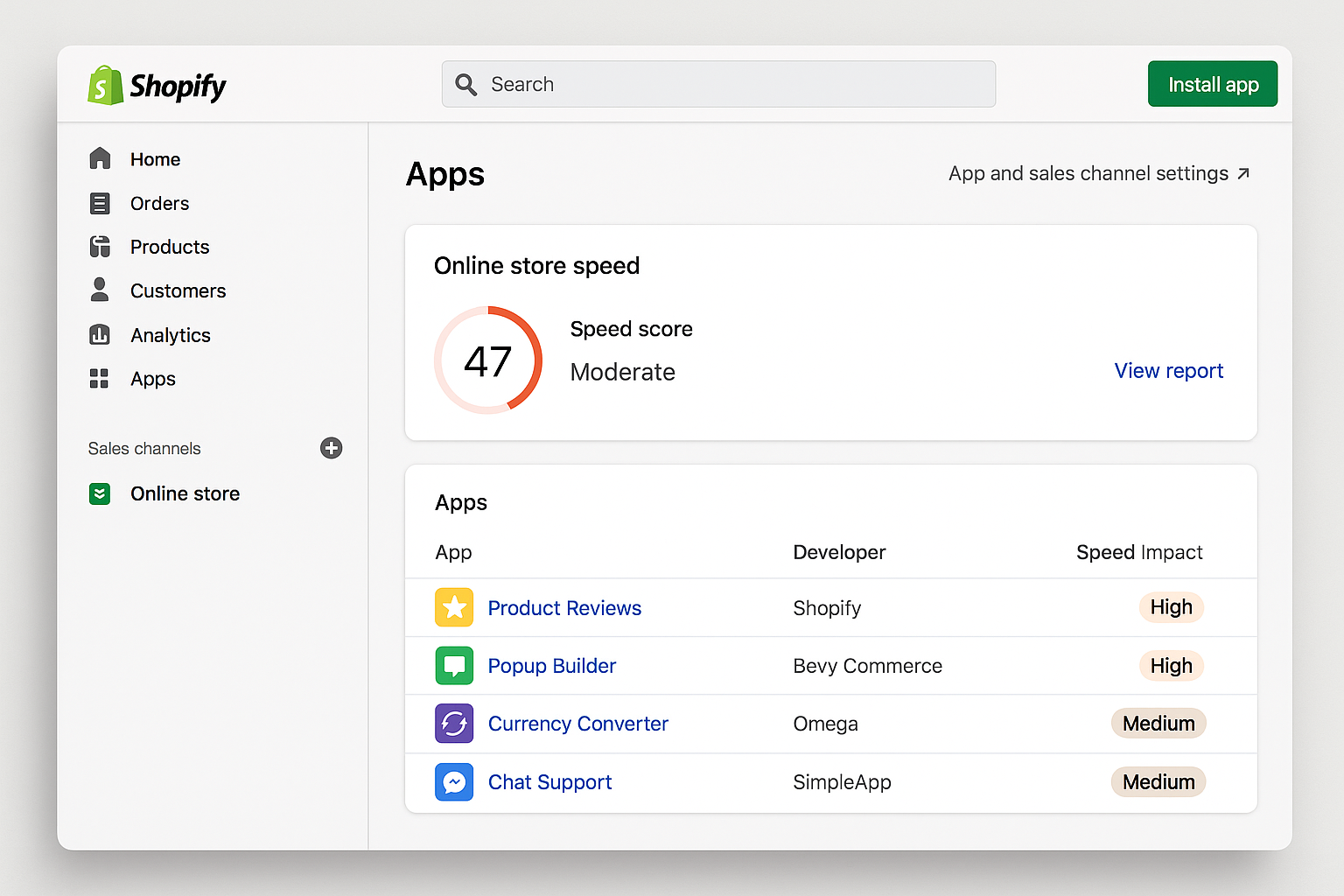
What No One Tells You About Shopify App Performance: My Experience with Optimizing Apps
Introduction: The Hidden Cost of Shopify App Overload
When I first launched my Shopify store, I was amazed by the variety of apps available. From upselling and reviews to chat support and pop-ups — there was literally an app for everything. But what I didn’t realize was that each of those apps came with a hidden price tag — performance .
In this article, I’ll share what I learned the hard way about Shopify app performance , how I optimized my store for speed, and the actionable steps you can take to make sure your apps work for you, not against you.
Why Shopify Apps Are Both a Blessing and a Curse
Shopify’s app ecosystem is one of its biggest strengths. It empowers even non-technical store owners to extend functionality with a few clicks. However, every app you install introduces additional scripts, requests, and code , which can bloat your site and slow down your load times. slow down your load times .
Apps often:
- Add external JavaScript or CSS files.
- Load unnecessary data on every page.
- Create background processes that run even when not needed.
The result? Slower performance , reduced SEO rankings, and a drop in conversions.
Understanding How Apps Affect Store Speed and Performance
Most Shopify apps inject code snippets directly into your theme. These snippets load during page rendering, increasing Time to Interactive (TTI) and First Contentful Paint (FCP) — two key Google metrics for speed .
Apps that rely heavily on APIs or external servers can delay page rendering until those calls complete. Review widgets, currency converters, and live chat apps are notorious for this. wordpress security tips
My Early Mistakes with Shopify App Installation
The Temptation of “There’s an App for That”
I was guilty of installing every app that promised better engagement or higher conversions. Countdown timers? Installed. Exit-intent popups? Installed. Review collectors? You guessed it — installed.
What I didn’t realize was that I was essentially stacking code on top of code , each running simultaneously and competing for bandwidth .
How Too Many Apps Slowed Down My Store
After a few weeks, I noticed my store took over 7 seconds to load — a nightmare in eCommerce terms. Google PageSpeed Insights was flashing red warnings everywhere. Bounce rates skyrocketed, and customers were leaving before pages even loaded. Shopify theme slowing you down
Metrics That Made Me Realize Something Was Wrong
- PageSpeed Score: Dropped from 85 to 48
- First Input Delay (FID): 410ms
- Conversion Rate: Fell by 22% These numbers were alarming. I knew I had to act fast.
The Technical Side: How Apps Impact Page Load Times
Frontend vs Backend Performance Issues
- Frontend: Too many app scripts slow down rendering.
- Backend: Apps with excessive API calls increase server response time.
Liquid Code, JavaScript, and API Calls — The Silent Killers
Shopify’s Liquid template language can become inefficient if apps add conditional logic or heavy snippets. Many apps inject JavaScript tags that block rendering, forcing browsers to wait before displaying content .
Common Culprits: Image Widgets, Pop-ups, and Reviews
- Review apps like Loox or Judge.me
- Pop-up managers
- Social proof notifications Each of these loads multiple external assets, creating bottlenecks.
My Optimization Journey: Step-by-Step Process
Step 1: Audit Every App for Necessity and Redundancy
I listed every app I had installed and asked: 👉 Does this add real value to the customer experience?
I removed over 10 redundant apps — many offering duplicate features.
Step 2: Identify the Heaviest Apps Using Speed Tools
Using Shopify Analyzer , GTmetrix , and Chrome DevTools , I pinpointed apps causing major delays. Some apps were making over 50 requests per page!
Step 3: Replace Multiple Apps with Multi-Function Alternatives
Instead of three separate apps for reviews, pop-ups, and rewards, I switched to Vitals , which consolidates all those features with cleaner code.
Step 4: Minify Code and Remove Unused Snippets
Even after uninstalling apps, residual code often remains. I manually cleaned up theme.liquid and removed leftover scripts. You can read about common reasons your website is sluggish .
Step 5: Use Shopify’s Native Features Before Installing Apps
Shopify now offers built-in tools like Discounts, Analytics, and Email Campaigns — no need for third-party apps when native solutions exist.
Real-World Results: Before and After Optimization
Speed Scores and Core Web Vitals Improvements
| Metric | Before | After |
|---|---|---|
| Page Load Time | 7.3s | 2.1s |
| PageSpeed Score | 48 | 89 |
| Bounce Rate | 58% | 29% |
Sales and Conversion Rate Impact
After optimization, my conversions jumped by 18% , and organic traffic improved because of higher SEO rankings .
Expert Tips to Maintain Shopify App Performance Long-Term
Schedule Regular Performance Audits
Every few months, evaluate your apps’ necessity and performance impact.
Keep Your Theme and Apps Updated
Developers release performance patches — always update promptly .
Monitor with Google PageSpeed Insights and Shopify Analyzer
These tools can alert you to slowdowns early before they affect user experience.
Best Lightweight Apps That Won’t Slow You Down
Recommended Apps for Speed and Functionality
- TinyIMG – for image compression and lazy loading.
- Vitals – multi-feature app with clean codebase.
- Shopify Inbox – lightweight chat support.
- ReConvert – post-purchase upsells without heavy scripts.
Image Optimization, Reviews, and Analytics Tools
Stick to apps that load scripts after user interaction instead of on page load.
For more insights, visit Shopify’s official performance guide .
FAQs: Shopify App Optimization Explained
Conclusion: Less Is More When It Comes to Shopify Apps
Shopify apps can transform your store — but only if managed wisely. My journey taught me that fewer, optimized apps outperform a cluttered setup any day. Keep your stack lean, test regularly, and focus on providing a fast, seamless shopping experience that keeps customers coming back.
Table of Contents
📧 Stay Updated
Get the latest web development tips and insights delivered to your inbox.




